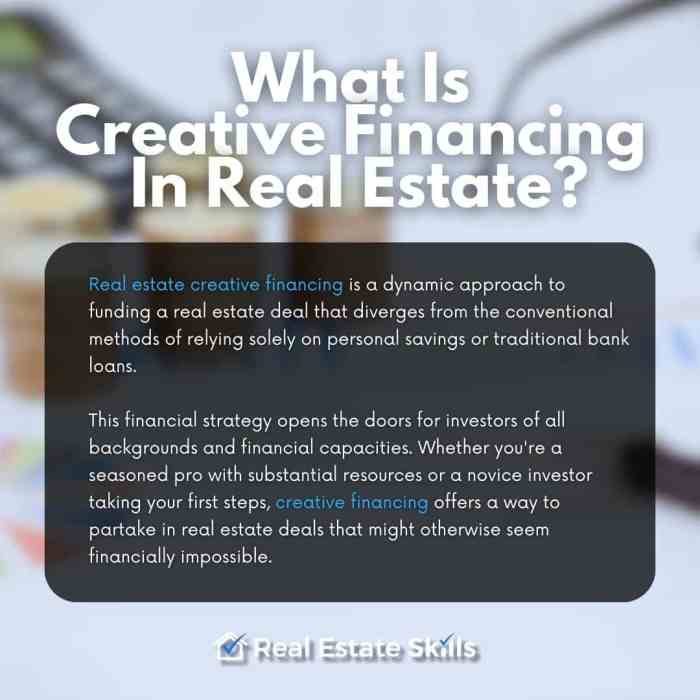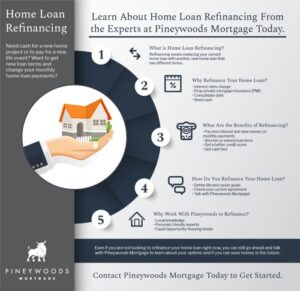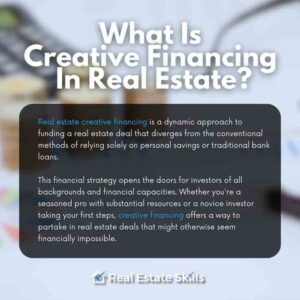
Kicking off with Creative financing in real estate, this approach opens up a world of possibilities for buyers and sellers alike. It offers innovative solutions that can break down barriers to property ownership, making real estate transactions more accessible for everyone.
By utilizing methods such as seller financing and lease options, individuals can navigate the complexities of financial constraints while still achieving their real estate goals. Understanding the benefits and risks associated with these creative financing methods is crucial for anyone looking to thrive in today’s competitive market.
Understanding Creative Financing in Real Estate
Creative financing in real estate refers to innovative and non-traditional methods of securing money for property transactions. It often provides solutions when conventional lending options fall short. Understanding this concept helps buyers and sellers navigate the complexities of real estate transactions, potentially unlocking opportunities that may otherwise be inaccessible.Creative financing methods present numerous advantages, such as lower upfront costs, flexible payment terms, and the ability to bypass strict lender requirements.
These methods enable buyers with limited access to capital or credit to acquire properties. Some common forms of creative financing include seller financing, lease options, and wrap-around mortgages. Each method serves as a tool that can enhance cash flow and provide additional investment benefits.
Seller Financing
Seller financing occurs when the property owner provides a loan to the buyer instead of the buyer obtaining a traditional mortgage from a bank. This arrangement can be beneficial for both parties, as sellers can receive direct payments and potentially earn interest on the loan. Buyers, on the other hand, may find this method easier to qualify for than standard financing options.In seller financing, the sales contract Artikels key details:
- Purchase price and down payment
- Interest rate and payment schedule
- Loan term and balloon payment conditions
- Provisions for default and foreclosure
This approach can lead to faster closings and reduced closing costs, making it an attractive option for those looking to streamline the buying process.
Lease Options
A lease option is another creative financing technique where a tenant rents a property with the option to purchase it at a later date. This arrangement allows buyers to lock in a purchase price while living in the home, providing them time to improve their credit score or save for a down payment.Key aspects of lease options include:
- Agreement on purchase price at the start of the lease
- Monthly rent payments, which may include a portion credited toward the purchase
- The length of the lease and option period
- Terms regarding maintenance and repairs
This method can be advantageous for both tenants and landlords, as it allows tenants to secure a home while providing landlords with steady rental income.
Risks Associated with Creative Financing
While creative financing offers several advantages, it also carries inherent risks that both buyers and sellers must consider. For buyers, the risks include potential higher interest rates compared to traditional loans, as sellers may charge a premium for the financing convenience. Additionally, buyers may face property maintenance responsibilities without owning the property outright, which can lead to unforeseen expenses.Sellers also encounter risks, such as the possibility of buyers defaulting on payments.
If a buyer fails to fulfill their obligations, it can result in lengthy legal battles and financial losses. Furthermore, sellers may tie up their capital in an unsecured loan, limiting their ability to invest in other opportunities.
Real-Life Examples
To illustrate the practical application of creative financing methods, consider the case of a young couple seeking their first home. Lacking sufficient credit history to qualify for a traditional mortgage, they approached a seller willing to provide financing. By negotiating a seller financing agreement, they were able to purchase the property with a low down payment and a manageable monthly payment plan, ultimately achieving their goal of homeownership.In another scenario, a landlord utilized a lease option to sell a rental property.
The tenant, interested in buying, agreed to a lease with an option to purchase the home at a predetermined price after two years. During this period, the tenant was able to improve their financial standing, ultimately leading to a successful sale that benefitted both parties.
Creative Financing Strategies for Real Estate Agents

Creative financing strategies provide real estate agents with unique tools to assist clients in achieving their property goals, especially in a competitive market. These strategies can help overcome traditional financing hurdles and offer innovative solutions tailored to individual client needs.One effective approach is to utilize seller financing, which allows the seller to act as the lender. This method can be particularly beneficial in situations where buyers may not qualify for conventional mortgages.
For instance, a real estate agent facilitated a transaction where the seller financed the purchase of a property, enabling a young couple to buy their first home without the burden of stringent bank requirements. This strategy not only simplified the transaction but also led to a successful sale for the seller, who received steady income from the loan.
Educational Resources for Clients on Creative Financing
To empower clients in understanding creative financing options, real estate agents can provide various educational resources that explain the concepts clearly. It is essential to ensure that clients are informed about the possibilities available to them. Here are some ways agents can educate their clients:
Workshops and Seminars
Organizing events that cover the basics of creative financing, such as lease options, subject-to financing, and wrap-around mortgages, can foster understanding and interest among potential buyers.
Informative Guides
Creating brochures or digital guides that Artikel different financing options and include case studies can greatly benefit clients. These materials should explain complex terms in layman’s language, making it accessible to everyone.
One-on-One Consultations
Offering personalized sessions where agents can discuss specific client circumstances and suitable financing options helps build trust and confidence. This tailored approach allows clients to ask questions and gain insights into the practical application of creative financing methods.
Online Resources
Utilizing social media platforms and websites to share articles, videos, and infographics about creative financing can reach a broader audience. Regularly updating clients on market trends and financing alternatives keeps them informed and engaged.
“Educating clients about creative financing not only enhances their buying experience but also positions agents as knowledgeable resources in the real estate market.”
By employing these educational strategies, real estate agents can enhance their clients’ understanding of creative financing, ultimately leading to more successful transactions and satisfied clients.
Impact of Creative Financing on Different Real Estate Segments

Creative financing has revolutionized various segments of the real estate market by providing innovative solutions to traditional funding obstacles. By leveraging unique financing methods, investors and buyers can navigate a competitive landscape more effectively. This impact is particularly notable when comparing residential and commercial real estate, as well as in specific scenarios such as home building projects, land purchases, foreclosures, and green real estate initiatives.
Comparison of Creative Financing in Residential and Commercial Real Estate
Creative financing strategies differ significantly between residential and commercial real estate. In residential transactions, methods such as seller financing, lease options, and subject-to financing enable buyers with limited credit or income to acquire properties. These strategies often appeal to first-time homebuyers or those facing financial challenges, allowing for more flexible payment structures.Conversely, commercial real estate often involves larger sums and complex transactions.
Here, creative financing mechanisms like equity partnerships, syndications, and crowdfunding can attract diverse investors interested in high-potential projects. Commercial properties often require significant capital for development or acquisition, making these creative strategies invaluable for raising funds and sharing risks among multiple stakeholders.
Facilitation of Home Building Projects and Purchase of Real Estate Land
Creative financing can significantly enhance the feasibility of home building projects and the acquisition of real estate land. Traditionally, buyers may face challenges securing loans for construction or land purchases due to high upfront costs. However, the use of alternative financing solutions, such as land contracts or builder financing, allows buyers to secure land or begin construction without the burden of immediate full payment.For instance, a buyer interested in building a custom home may enter into a land contract with the seller, allowing them to pay a portion of the purchase price upfront while making monthly payments until the total is settled.
This arrangement not only provides immediate access to the property but also eases the financial burden during the building phase.
Role of Creative Financing in Foreclosures and Green Real Estate Initiatives
Creative financing plays a crucial role in the acquisition of foreclosures, allowing investors to capitalize on distressed properties. Techniques such as hard money loans or private financing are often utilized to quickly secure these properties before traditional buyers can enter the market. By employing these rapid funding methods, investors can rejuvenate foreclosed homes, making them attractive for resale or rental.In the context of green real estate initiatives, creative financing is vital for funding eco-friendly developments.
Programs such as Property Assessed Clean Energy (PACE) financing enable property owners to obtain upfront funds for energy-efficient renovations, with repayment tied to their property taxes. This approach promotes sustainability while alleviating the financial strain associated with environmentally friendly upgrades.
Creative financing not only opens doors to homeownership but also supports sustainable development practices, enhancing property value and community well-being.
Final Thoughts
In summary, creative financing in real estate serves as a powerful tool that can transform the way we approach property transactions. By leveraging these strategies, both buyers and sellers can find unique solutions that cater to their specific needs, ultimately leading to successful deals and a thriving real estate landscape.
FAQ Overview
What is creative financing in real estate?
Creative financing refers to non-traditional methods of financing real estate transactions, allowing buyers and sellers to structure deals that meet their unique needs.
What are the benefits of creative financing?
Benefits include increased flexibility, access for buyers who may not qualify for traditional loans, and potential for better terms for both parties.
What risks are associated with creative financing?
Risks can include potential legal issues, the possibility of higher costs, and the need for thorough due diligence by both parties.
How can real estate agents utilize creative financing?
Agents can educate clients on available options, help structure deals using creative methods, and showcase successful case studies to build trust and confidence.
Is creative financing suitable for all types of real estate?
While it can be beneficial in various segments like residential and commercial real estate, it’s essential to evaluate the specific circumstances of each transaction.





